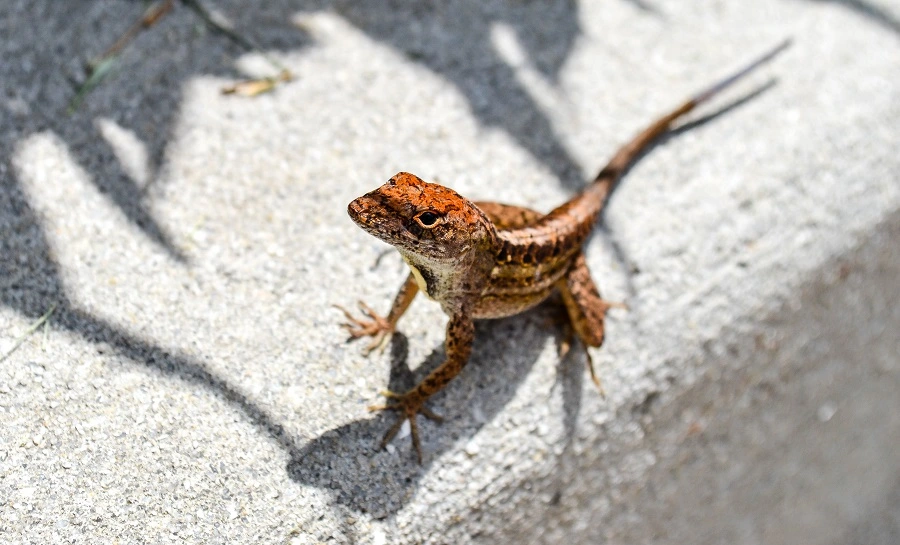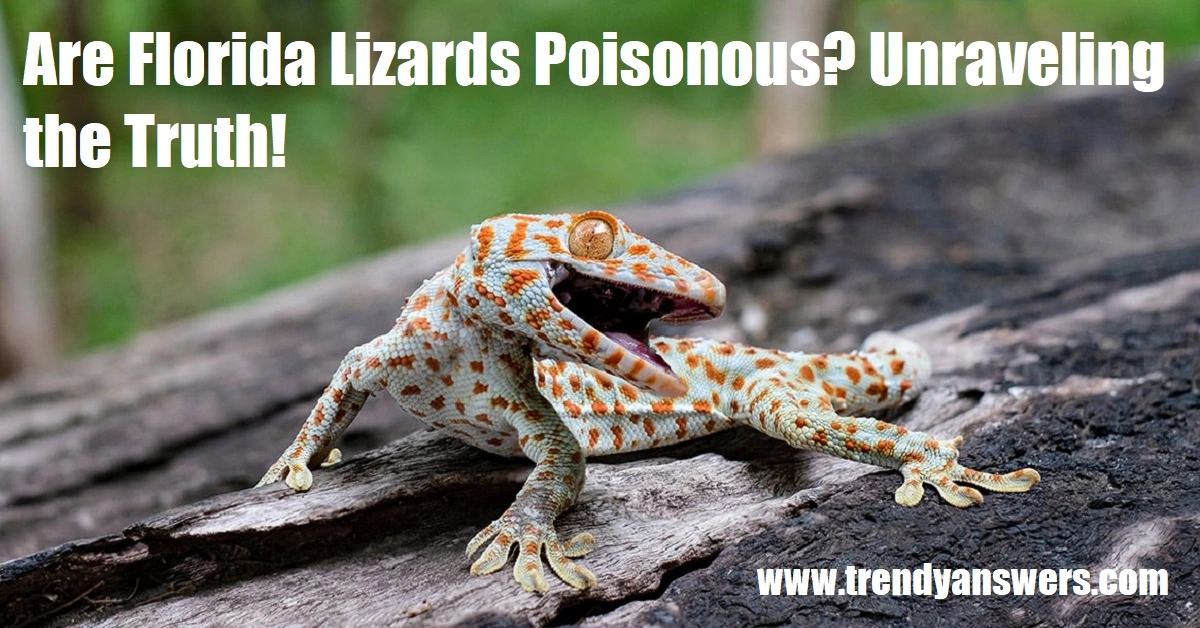Are Florida Lizards Poisonous? Florida is known as home to a various range of wildlife, and lizards as well. With its warm and humid climate, the state provides an ideal habitat for these fascinating reptiles. While many species of lizards are harmless and even beneficial to the environment, some can deliver venomous bites. In this article, we will share the complete details about lizards found in Florida, distinguish their species, understand their behavior, and address how to safely interact with them.

Also Read: How are Viruses Different from Bacteria Apex? Ultimate Guide
Florida Lizards: An Overview
Before we start discussing the topic of poisonous lizards, let’s understand first the diverse array of lizards inhabiting Florida.
Types of Lizards Found in Florida
Florida boasts an impressive variety of lizards, each with its unique characteristics. Among the commonly sighted lizards are:
- Green Anole (Anolis carolinensis): Known for its color-changing ability and vibrant green hue, the green anole is a non-venomous lizard often found climbing trees and shrubs.
- Eastern Fence Lizard (Sceloporus undulatus): This non-venomous lizard is characterized by its spiky scales and the distinctive dark lines running along its back.
- Six-Lined Racerunner (Aspidoscelis sexlineatus): Also renowned for its incredible speed, the six-lined racerunner is a non-venomous species frequently spotted darting across open areas.
- Brown Anole (Anolis sagrei): Another non-venomous lizard, the brown anole, is well-known for its ability to change color, ranging from brown to green.
Venomous Lizards in Florida
While most lizards in Florida are harmless, a few species possess venomous properties. It’s essential to identify these potentially dangerous reptiles to ensure personal safety.
The Eastern Coral Snake (Micrurus fulvius)
The Eastern Coral Snake is one of Florida’s venomous lizards, and it bears a resemblance to the non-venomous Scarlet King Snake, leading to potential confusion. If you found with red and yellow bands touch, it is venomous, and if you dound red and black bands touch, it is kind of non-venomous.
The Gila Monster (Heloderma suspectum)
The Gila Monster is not native to Florida, but it is vital to be aware of its existence due to its venomous bite. It features distinctive black and orange bead-like scales, serving as a warning sign to potential predators.
The Green Anole (Anolis carolinensis)
Although the green anole is generally harmless, it is worth mentioning that it possesses mild venom. However, this venom is not harmful to humans and is primarily used to subdue its insect prey.
Non-Venomous Lizards in Florida
Now that we have explored the venomous lizards let’s shift our focus to the more common non-venomous species that inhabit the region.
The Eastern Fence Lizard (Sceloporus undulatus)
The Eastern Fence Lizard is a docile reptile known for its intriguing territorial displays, often seen performing push-ups on fences or trees.
The Six-Lined Racerunner (Aspidoscelis sexlineatus)
As its name suggests, the Six-Lined Racerunner is swift, agile, and non-venomous. This lizard prefers open sandy areas and can often be seen basking in the sun.
The Brown Anole (Anolis sagrei)
The Brown Anole, though non-venomous, is known for its competitive nature, especially with the native Green Anole, leading to a decline in the Green Anole population.
How to Identify Poisonous Lizards
When you noticed lizards around or your way in Florida, it’s important to differentiate if they are venomous or non-venomous. This important thing can prevent any unfortunate incidents and promote coexistence.
Physical Characteristics
Venomous lizards often possess distinct markings or color patterns, serving as a warning to potential predators. These visual cues can help identify the venomous species.
Behavioral Cues
Observing a lizard’s behavior can also provide valuable information. Venomous lizards may display aggressive behavior or make hissing sounds when threatened.
Behavior and Habitat
Understanding lizard behavior and preferred habitats can enhance our appreciation of these reptiles and ensure safer interactions.
Camouflage and Defense Mechanisms
Both venomous and non-venomous lizards, use camouflage to mix-up into surrounding colors, evading predators. Additionally, they may employ defensive tactics such as tail shedding to escape from potential threats.
Preferred Habitats
Different lizard species favor various environments, ranging from forests and grasslands to urban areas. Knowing their preferences can increase the likelihood of encountering them in the wild.
Interaction with Humans
Encounters between humans and lizards are relatively common in Florida, and knowing how to handle such situations is crucial for both parties’ well-being.
How to Handle Encounters
If you come across a lizard, remain calm and avoid sudden movements. Respect the lizard’s space and observe from a safe distance to prevent startling the creature.
Precautions to Take
While most lizards are harmless, it’s essential to avoid provoking or attempting to handle venomous species. If unsure about a lizard’s identity, it’s best to admire it from afar.
Importance of Lizards in the Ecosystem
Lizards play a significant role in the ecosystem by controlling insect populations, pollinating flowers, and serving as prey for various predators. Understanding their ecological importance fosters a greater appreciation for their existence.
Conservation Efforts
Due to habitat loss and various threats, some lizard species in Florida face conservation challenges. Supporting conservation initiatives and preserving natural habitats can contribute to their survival.
Conclusion
In conclusion, lizards are fascinating creatures that contribute to Florida’s rich biodiversity. While some lizards in Florida may possess venomous properties, they are generally not a threat to humans if left undisturbed. It is also essential to respect their habitats and observe them from a safe distance to ensure coexistence.
By understanding the differences between venomous and non-venomous species, as well as their behavior and preferred habitats, individuals can enjoy observing these captivating reptiles without endangering themselves or the lizards.
Also Read: 5 types of Important Insurance every person should have in US
FAQs
- Are all lizards in Florida venomous?
- No, the majority of lizards in Florida are non-venomous, and they pose no threat to humans.
- How can I identify a venomous lizard?
- Venomous lizards often have distinct color patterns or markings, and some may display aggressive behavior when threatened.
- Are bites from venomous lizards dangerous to humans?
- While bites from venomous lizards can cause discomfort, they are generally not life-threatening to humans. Seek medical attention if bitten to be safe.
- What should I do if I encounter a lizard in my garden?
- If you encounter a lizard, maintain a safe distance and also allow it to go about its activities undisturbed.
- Can I keep lizards as pets in Florida?
- Yes, some non-venomous lizard species can be kept as pets, but it is essential to research their care requirements and ensure they are legal to own.
